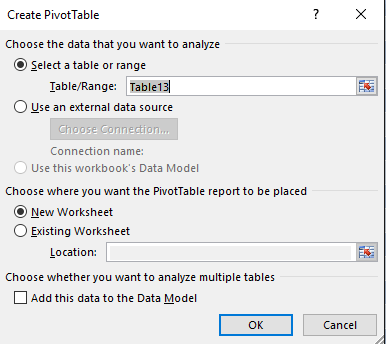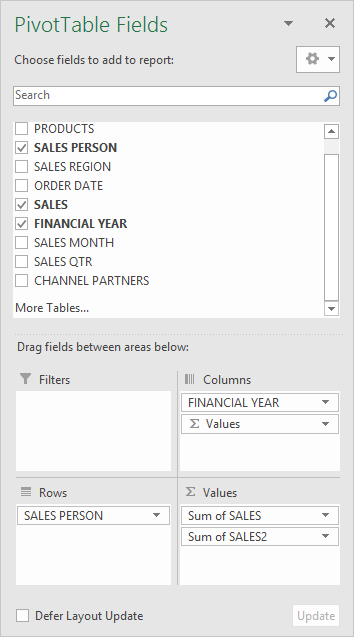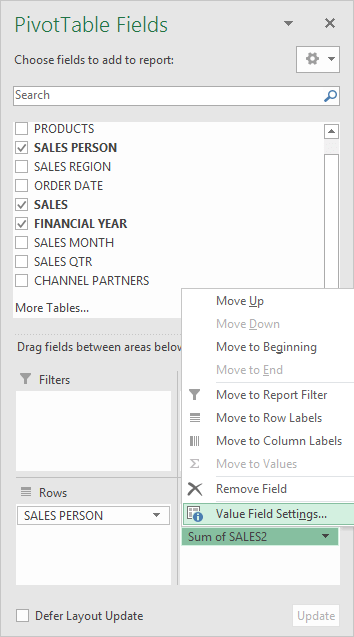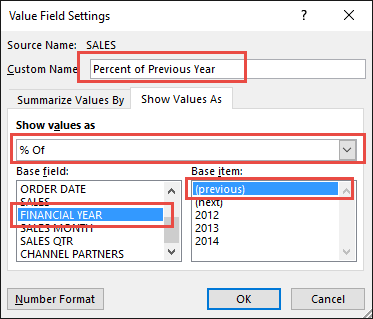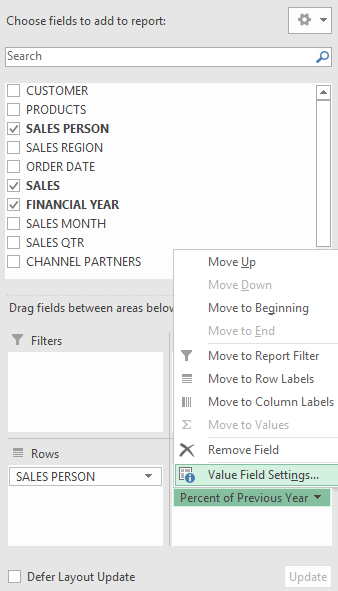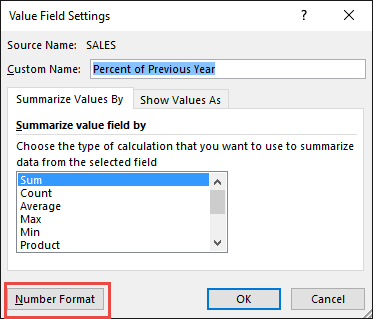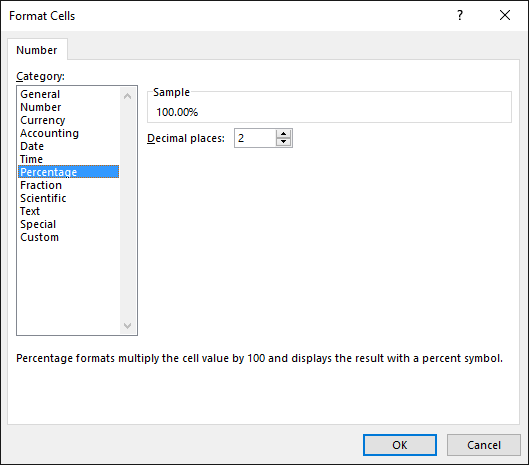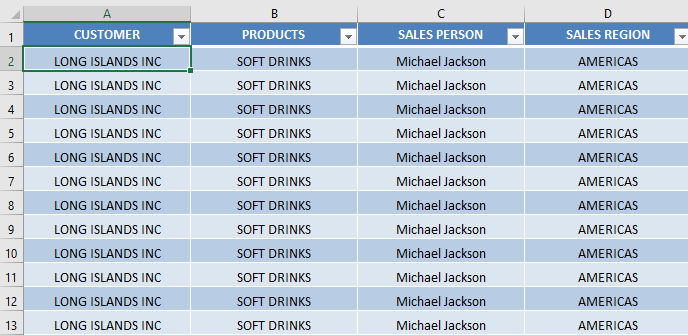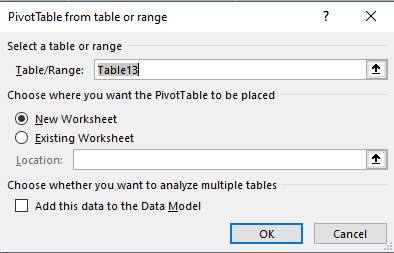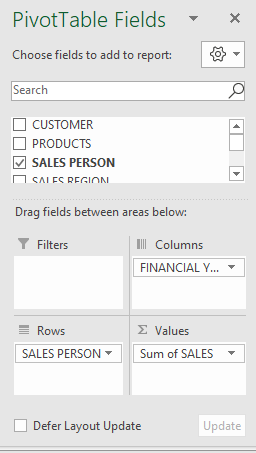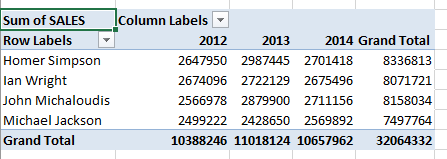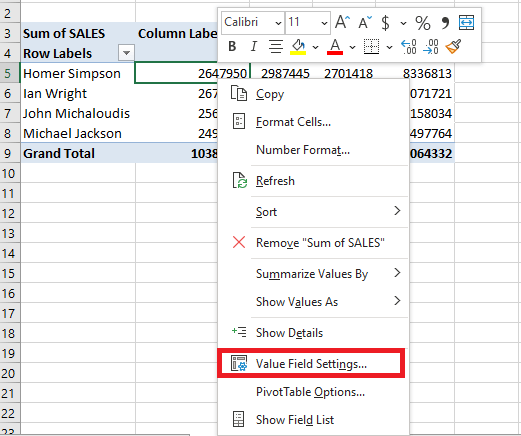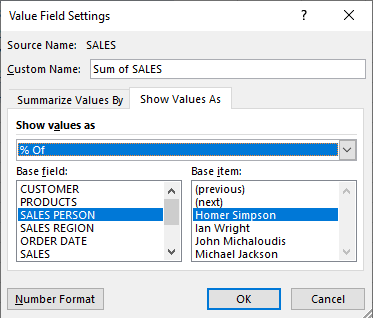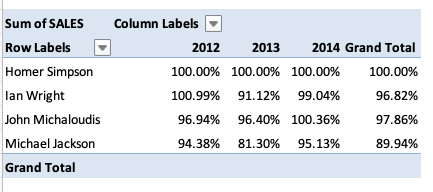Excel Pivot Tables have a lot of useful calculations under the SHOW VALUES AS option and one that can help you a lot is Add Percentage to Pivot Table.
It will display the value of one item (the Base Field) as the percentage of another item (the Base Item).
This option will immediately calculate the percentages for you from a table filled with numbers such as sales data, expenses, attendance, or anything that can be quantified.
Key Takeaways
- Easily Show Percent of Total – In a Pivot Table, you can display values as a percentage of the total by selecting the field, right-clicking, and choosing Show Values As > % of Total. This helps to compare data in relative terms.
- Customize the Calculation – You can calculate the percent of rows, columns, or grand totals by adjusting the “Show Values As” option, allowing for more specific data analysis.
- Show Percent of Row or Column – Excel allows you to display the percentage relative to a row or column total, providing insights into how individual data points contribute to the overall values.
- Use Percent of Grand Total for a Clear Overview – By showing the percent of the grand total, you can get a quick summary of how each value contributes to the overall dataset, making it easier to spot trends and outliers.
- Update Dynamically – The percentage values in Pivot Tables update automatically when the underlying data changes, ensuring that you always work with the most up-to-date calculations.
In this example, you have a pivot table with Sales person in the row area and the year in the column area.
Table of Contents
% of Year
Follow the step-by-step tutorial on How to Add Percentage to Pivot Table and download this Excel workbook to practice along:
Download excel workbookPercent-Of.xlsx
STEP 1: Insert a new Pivot table by clicking on your data and going to Insert > Pivot Table > New Worksheet or Existing Worksheet
STEP 2: In the ROWS section put in the Sales Person field, in the COLUMNS put in the Financial Year field and in the VALUES area you need to put in the Sales field twice, I explain why below:
Here is how the Pivot Table Percentage looks like:
STEP 3: Click the second Sales field’s (Sum of SALES2) drop down and choose Value Field Settings
STEP 4: Select the Show Values As tab and from the drop down choose % of.
For the Base Field pick Financial Year.
For the Base Item pick (previous).
This means we want to get the % of values based on the previous Financial Year.
Also, change the Custom Name into Percent of Previous Year to make it more presentable. Click OK.
STEP 5: Notice that the Percent of Previous Year data is in a decimal format that is hard to read:
To format the Percent of Previous Year column, click the second Sales field’s (Percent of Previous Year) drop down and choose Value Field Settings.
The goal here is for us to transform numbers from a decimal format (i.e. 0.23), into a percentage format that is more readable (i.e. 23%).
STEP 6: Click the Number Format button.
STEP 7: Inside the Format Cells dialog box, make your formatting changes within here and press OK twice.
In this example, we used the Percentage category to make our Percent of Previous Year numbers become more readable.
Following these steps you can add Percentage to Pivot Table, showing the Percent of Previous Year for the sales data of years 2012, 2013, and 2014.
All of the sales numbers are now represented as a Percentage of the Previous Year (Year 2013 is represented as a Percentage of Year 2012, and Year 2014 is represented as a Percentage of Year 2013):
% of Salesperson’s Sales
Instead of showing % of Year, you can even display % of Salesperson’s Sales in the Pivot Table. Follow the steps below to do so:
STEP 1: Click on any cell in the data table.
STEP 2: Go to Insert > Pivot Table.
STEP 3: In the Create PivotTable dialog box, select the table range and New Worksheet and then click OK.
STEP 4: In the PivotTable fields dialog box, drag and drop Sales person in Rows area, Year in Columns area, and sales amount in values area.
A Pivot Table will be displayed on your worksheet!
STEP 5: Right Click on any value in the Pivot Table and select Value Field Setting.
STEP 6: In the Value Field Setting dialog box, Under Show Values As Tab select % Of > SALES PERSON > Homer Simpson.
This will add percentage to Pivot Table!
Excel will display 100% for all values for Homer and it will be compared to itself. For other salespersons, Excel will show sales amount as a percentage of Homer’s sales for that particular year.
Frequently Asked Questions
How do I show data as a percentage of the total in an Excel Pivot Table?
To show data as a percentage of the total, right-click the value field in the Pivot Table, select Show Values As, and then choose % of Total. This will display the values as a percentage of the overall total.
Can I show percentages for rows or columns instead of the grand total?
Yes, you can display percentages relative to rows or columns. Right-click on the field in the Pivot Table, select Show Values As, and choose either % of Row Total or % of Column Total to show percentages based on those totals.
Will showing percentages update automatically when the data changes?
Yes, when you change the underlying data in the Pivot Table, the percentage values will update automatically, ensuring that you are always working with the most current calculations.
Can I calculate the percentage of a specific item instead of the grand total?
Yes, you can calculate the percentage for specific items within the Pivot Table by selecting the item, right-clicking, and choosing Show Values As to set it as a percentage of the desired field (e.g., row total or column total).
How can I show the percent of grand total in Excel Pivot Tables?
To show the percent of grand total, right-click the value in the Pivot Table, go to Show Values As, and select % of Grand Total. This will display each value as a percentage of the entire dataset, helping to identify its proportion relative to the total.

Bryan
Bryan Hong is an IT Software Developer for more than 10 years and has the following certifications: Microsoft Certified Professional Developer (MCPD): Web Developer, Microsoft Certified Technology Specialist (MCTS): Windows Applications, Microsoft Certified Systems Engineer (MCSE) and Microsoft Certified Systems Administrator (MCSA).
He is also an Amazon #1 bestselling author of 4 Microsoft Excel books and a teacher of Microsoft Excel & Office at the MyExecelOnline Academy Online Course.

